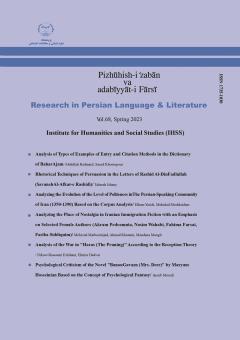Analysis of the War in "Haras (The Pruning)" According to the Reception Theory
Subject Areas : Islamic Revolution and sacred defense literatureNikou Ghassemi Esfahani 1 , Elmira Dadvar 2
1 - PhD Student in French Literature University of Tehran, Iran.
2 - Professor in Comparative Literature University of Tehran, Iran.
Keywords: War literature, "Haras (The Pruning)", Nasim Mar’ashi, Reception theory, Wolfgang Iser. ,
Abstract :
Reception theory, places a premium on and holds the role of reader in interpreting the text in high regard. Wolfgang Iser is one of the founders of this theory, which believes a text has two artistic and aesthetic poles and relegates the role of meaning creator to the reader. The texts classified as War literature have always had their audiences in the Persian contemporary literature. By having a critical approach to the Iran-Iraq war, different content and a new structure, "Haras (The Pruning)"of NasimMar’ashi, has managed to change the horizon of expectation of Iranian readers concerning War literature. In this paper, the two artistic and aesthetic poles of this novel will be analyzed based on Iser’s views on the reception theory and then we will refer to the elements that have influenced the interaction between readers and the text, leading to a new perception of war. Furthermore, this article attempts to analyze how this text has managed to satisfy the curiosity of contemporary readers by using modern and original elements.
اسکویی، نرگس (1399) «تحلیل دیدگاه نجات زمین توسط زنان در رمان هرس با رویکرد بوم فمینیستی»، نشریه زن در فرهنگ و هنر. شماره 4، صص 567- 586.
پرهیزکار، زرین¬تاج (1401) «بررسی ادبیات اقلیمی در رمان هرس اثر نسیم مرعشی»، فصل نامه علمی تفسیر و تحلیل متون زبان و ادبیات فارسی (دهخدا)، دوره 14، شماره 51، صص 341- 371.
پویان، مجید، محمدرضا نجاریان و الهام حسن¬شاهی (1399) «شهر زنان در سام¬نامه و پیگیری ردپای آن در ادبیات فارسی»، متن¬پژوهی ادبی، سال 24، شماره 84، صص 211- 242.
حسن¬زاده نیری، محمدحسن، اعظم زنگنه و آزاده اسلامی (1399) «تحلیل رمان هرس بر اساس نظریه سوگ»، پژوهشنامه ادبیات معاصر ایران، شماره 3، صص 149-166.
حیدری، منیره، حسین پارسایی و حسام ضیایی (1398) «بررسی شخصیت¬پردازی زنان در رمان هرس»، نشریه زن و فرهنگ،سال دهم، شماره 40، صص 67-80.
دماوندی، مجتبی و جعفری فاطمه کمانگر (1391) «رمان مدرن روایتی دیگرگونه و دیریاب»، متنپژوهی ادبی، شمارة 53، صص 133-156.
رستمی، فرشته (1389) «زیبایی¬شناسی دریافت در «دل فولاد»، پژوهش¬های ادبی، سال 7، شمارة 29 و 30، صص 49-70.
سعیدی، مهدی (1385) «رویکردهای عمدة ادبیات داستانی جنگ (1384-1359)»، پژوهش زبان و ادب فارسی، شمارة هفتم، صص 36-21.
سلدن، رامان و پیتر ویدوسون (1397) راهنمای نظریة ادبی معاصر، ترجمة عباس مخبر، تهران، بان. شجاعت¬زاده، تهمینه، نرگس اسکویی و آرش مشفقی (1399) «نظریه افتراق زنان و تحلیل آن در رمان هرس»، نقد و نظریه ادبی،سال پنجم، دوره اول، صص 123-142.
صهبا، فروغ (1391) کارکرد ابهام در فرآیند خوانش متن، تهران، آگه.
مرعشی، نسیم (1396) هرس، چاپ شانزدهم، تهران، چشمه.
میرعابدینی، حسن (1377) صد سال داستان¬نویسی، ج 3، تهران، چشمه.
نامور مطلق، بهمن (1387) «یاوس و ایزر: نظریة دریافت»، پژوهشنامة فرهنگستان هنر، شمارة 11، صص 93-110.
Calas, F. et Charbonneau, D-R (2002) Méthode de commentaire stylistique, Paris,Éditions Nathan.
Iser, W (1976) L’acte de lecture : théorie de l’effet esthétique, Bruxelles,Éditions Mardag.
Gilli, Y., « Le texte et sa lecture. Une analyse de l'acte de lire selon W. Iser», Semen,1983, 1-11, available from: http://journals. openedition. org/semen/4261,DOI: 10. 4000/semen. 4261.


